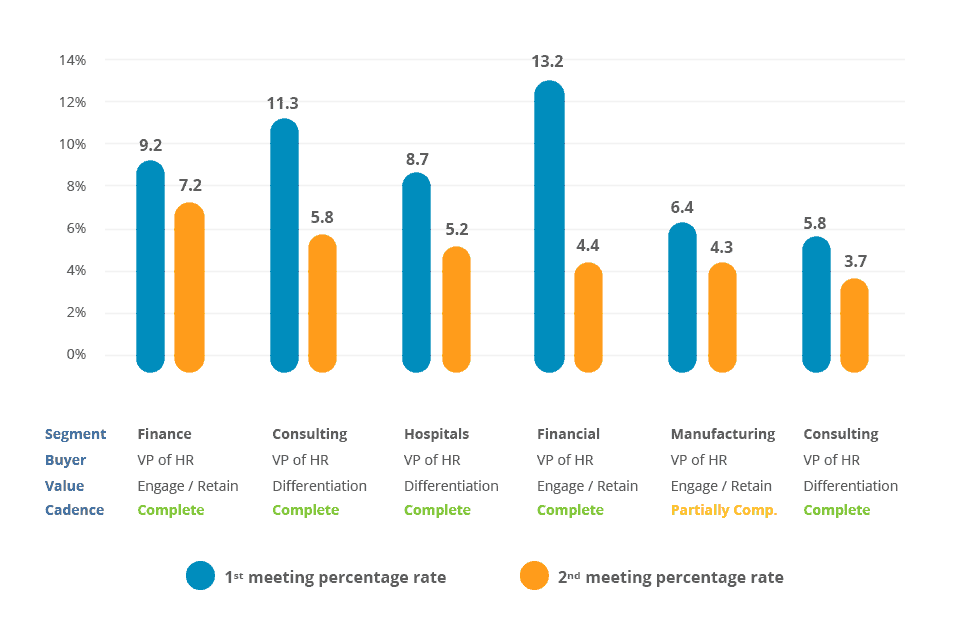When AdmitHub was emerging as the premiere AI-based conversational messaging platform to help colleges with new student enrollments and higher student retention rates, most of its new prospect leads were inbound from director-level or manager-level staff in admissions or marketing offices.
Brian Ruhlmann, AdmitHub’s Director of Sales and Marketing, wanted to figure out how to more quickly engage senior campus leaders and decision-makers. The director- or manager-level staff who were quick to engage often struggled to get the attention of these higher ups who controlled the purse strings. So, Brian designed an innovative series of outbound prospecting campaigns he called the “Big Cheese” initiative.
It took just six months for the Big Cheese initiative to take AdmitHub’s prospecting to a whole new level. At the start of the initiative, just 1 in 6 of new prospect meetings came from outbound prospecting. Six months later outbound meetings had doubled to 30% of all new prospect calls. And, almost all that increase in new meetings was with economic buyers at the Associate VP level or above.
What was it that led to this performance shift? Three components of the Big Cheese initiative made the difference. First was a new approach to messaging. Prior to these campaigns, outbound prospecting relied heavily on positioning the transformational power of AI with phrases like “hire AI,” “AI earlier adopter,” and “AI flywheel.” In the Big Cheese campaigns, the focus was on the buyer benefit of deploying conversational AI, things like “recruiting GenZ,” “higher yield” and “enrollment productivity.” These were important issues for senior level college decision makers.
The second important change was a new approach to outreach. Prior to the Big Cheese campaigns, AdmitHub’s outbound prospecting also relied almost exclusively on high-volume email-only sequences. The Big Cheese campaigns introduced a mixed series of touches, including emails, calls, voicemails, and even a book direct mailing. The book, written by one of AdmitHub’s co-founders, was sent to Provosts, CIOs, and VPs of Enrollment Management. The mixed-touch sequence, and particularly taking the time to mail a book, caused the company to stand out.

Prospecting Cadence: Make Each Campaign a Market Test
The third important change, and the most critical for long-term success, was AdmitHub’s commitment to learning and continuous improvement throughout the initiative. The key to effective prospecting is agile, but structured, market testing. Committing to continuous prospect tests over a 6+ month period can build average performance gains of 40% to 45% in new opportunity production. The agile tests need to carefully consider the mix of value phrases, market segments and buyer roles that can lead to more first meetings. Committing to market testing and building a feedback loop with results shifts the prospector’s mindset from thinking about prospecting as a menial task for “phone monkeys” to thinking of it as the tip of the spear in understanding buyer value. AdmitHub’s initiative shifted the mindset of prospectors to “market sleuth.”
The Keys to Effective Prospecting
AdmitHub’s Big Cheese initiative achieved its goals of reaching senior decision makers more quickly, engaging them and converting meetings into opportunities because the team approached prospecting in a whole new way. Contrary to how most organizations approach outbound prospecting, the most effective prospecting incorporates:
- A focus on buyer value
- Sustained mixed-touch outreach
- Agile but structured market testing
Successful prospecting starts with understanding what benefits the target buyer values, incorporates this understanding into outreach that includes a combination of outreach methods including phone calls, and engages the prospecting team in learning and improving through market testing.
One aspect of prospecting that many teams struggle with is phone outreach. The most effective approach, however, must include phone outreach. In fact, a study by Salesforce found that phone-led outreach was 274 times more effective than email-led outreach. It involves what Ken Krogue, a XANT (formerly InsideSales) co-founder, calls “pleasant persistence.” Unfortunately, XANT’s research also shows that while maximum yield to first meetings happens with 6 call attempts to the same contact, the average seller makes just 1.4 outreach attempts.
Related, a recent study by ValueSelling Associates found 48% of sales professionals are afraid to pick up the phone and make cold calls and 60% lack organization and consistency with outreach efforts. Both lead sales teams to fall back on the easier, higher volume email blast sequences.
Like AdmitHub, your company can make consistency rewarding by thinking about prospecting as a testing and learning activity rather than a mind-numbing chore. For Brian and the small team of SDRs that continued AdmitHub’s prospecting momentum in the middle of 2018, getting on the phone seemed a lot more interesting when they thought of their role as the tip of the spear in figuring out specific buyer challenges and pains.
Becoming a Prospecting Sleuth
Making both phone outreach and prospecting consistency rewarding starts by shifting the prospector’s mindset from prospecting as a menial task for “phone monkeys” to prospecting as a “market sleuth” figuring out how to get to more discovery meetings quicker to drive faster sales revenue production. Sustaining that mental shift, however, requires a number of changes in prospecting tactics and activities.
Here are five key elements of sustaining a shift to Prospecting as a Market Sleuth:
- Make each campaign a market test
Test the impact of your messaging by running parallel campaigns each with a different value message to a single buyer persona in a single market segment. This helps everyone quickly understand where they can win faster.
- Prospect as trusted advisor
Help prospectors understand that their outreach is key to understanding buyers. Shape their outreach around buyers’ priorities and challenges NOT product features or your company story. This is called Prospecting as a Trusted Advisor.
- Use “smart blasts” to encourage calling
You can increase prospectors’ appetite for calling with targeted “smart blasts” that use a single value message to 200-400 contacts for the same buyer personas to qualify interest. Those that open with emails are touched with a mixed cadence.
- Write out 8-touch mixed cadence
If you write your value message by buyer persona into 8 to 9 email, call, vmail sequences with planned timing across 3 to 4 weeks, you create the expectation for persistence. You help prospectors stretch themselves from the 1.4 typical touches to something closer to 8, which is much more effective.
- Schedule prospecting blocks
Another helpful practice in building commitment is consistent, disciplined prospecting in scheduled 2- to 3-hour prospecting blocks at least three to four times a week. The blocks focus on nothing but call and email outreach to net new prospects.
Becoming a Manager Sleuth
The other key to making consistency rewarding is the commitment by the sales manager overseeing prospecting activities to closing the loop on market learnings. Prospectors are going to feel a lot more motivated to conduct outreach consistently if it is obvious how these efforts contribute to their own productivity, financial success and faster sales growth for the team.
Here are two key elements of becoming a Manager Sleuth:
- Team iteration and learning sessions
Commit to a weekly team session for peer sharing on prospect call pick ups and email responses. During peak periods of testing and learning, twice weekly is even better. Questions for sharing: what value messages are working, not working? What language adjustments did prospectors make? What language adjustments landed?
- Structured campaign comparisons
Prospecting managers need to commit to monthly and quarterly measurement across campaigns. Direct comparison of campaigns shows which messages, segments, and target buyers lead to highest productivity. Measurement should focus on the number of 1st meetings (ideally the % contact to 1st meeting conversion rate) and the quality of 1st meetings (meaning the % 1st meetings that progress to a 2nd meeting).

Prospecting Quality to 1st and 2nd Meeting Progression
Prospecting Impact
The shift to prospecting as a Market Sleuth can build average performance gains of 40% to 45% in contact to initial discovery call conversion rates. The foundation of securing these gains is building a prospecting test plan over a 6+ month period to test for key combinations of value phrases, market segments and buyer roles that build 1st meeting productivity.
AdmitHub’s prospecting tests focused on the impact of key value phrases that created engagement for different senior university buyers. By comparison, caregiver platform Torchlight designed a set of agile prospecting campaigns to find the highest productivity market sectors. Torchlight had a proven value proposition with clear and measurable benefits around employee engagement and employer cost savings.
In early 2018, Torchlight’s incoming VP of Sales Melissa Fowler was interested in “figuring out how to align this value prop to the ‘highest performing’ sectors for direct sales motion.” Melissa was charged with moving beyond an old prospecting approach that relied heavily on “spray and pray” email campaigns toward building a repeatable prospecting approach.
The company had grown successfully through channel partnerships, but did not have access to that channel partner’s sales and marketing data, so had only an anecdotal understanding of what drove new buyer engagement. As a result, Melissa’s program needed to focus on quickly learning about how to engage direct buyers and applying these learnings immediately to improve results.
Over a 6-month period of time, the Torchlight team put together 13 agile campaigns with mixed email, call, vmail touch cadences to employers in Financial Services, Life Sciences, Professional Services, Manufacturing, and Energy sectors, as well as Employer of Choice recipient award winners. The initiative put the Torchlight team on pace to increase its first call productivity by 61% over the next 12 months.
For both Torchlight and AdmitHub, the shift to prospecting as a Market Sleuth led to not only a significant uptake in their number of discovery calls but also the quality of those discovery calls. As the companies learned how to better engage their target buyers, they experienced higher early funnel deal velocity with significant gains in deal progression from a 1st meeting to 2nd meeting and to closed won deals. AdmitHub learned that AVP and higher decision makers progressed from a 1st meeting to a closed won deal at a 21% rate compared to a 7% rate when 1st meetings were with director-level or below. For Torchlight, overall 1st to 2nd call progression across all engaged buyers increased by about 20%.
Assessing Your Prospecting: A Simple Self-Diagnostic
Here are a few questions you can ask yourself to see how well you are managing prospecting and how effective you are at encouraging your team members to think about their role as “market sleuth” to build motivation for consistent outreach:
- Is your prospecting culture focused “pumping out volume” or “learning from the market”?
- Does your outreach messaging focus on specific buyer challenges and your company’s expertise?
- Do you script out 8+ email, call, vmail cadences to encourage persistence?
- Do you have prospectors schedule dedicated prospecting blocks?
- Do you do A/B testing on sales campaigns to measure the fastest path to quality 1st meetings?

